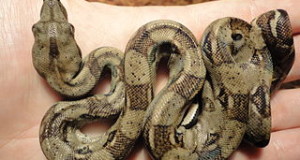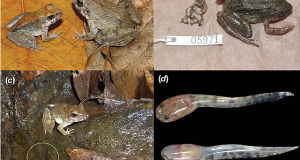 An article to be published later this month (Zootaxa; August, 2008) will announce that a newly described Thread Snake from the Caribbean island of Barbados is the smallest of the world’s 3,100+ snake species. The Barbados Thread Snake grows to a mere 4 inches in length, is no thicker than a strand of spaghetti, and can coil comfortably atop a quarter. It subsists largely upon ant and termite larvae, and may be threatened by habitat loss. A relatively large hatchling – ½ of the adult size – emerges from the single egg laid by the female (perhaps there is no prey species tiny enough to support a larger brood of smaller-sized young).
An article to be published later this month (Zootaxa; August, 2008) will announce that a newly described Thread Snake from the Caribbean island of Barbados is the smallest of the world’s 3,100+ snake species. The Barbados Thread Snake grows to a mere 4 inches in length, is no thicker than a strand of spaghetti, and can coil comfortably atop a quarter. It subsists largely upon ant and termite larvae, and may be threatened by habitat loss. A relatively large hatchling – ½ of the adult size – emerges from the single egg laid by the female (perhaps there is no prey species tiny enough to support a larger brood of smaller-sized young).
A related snake, nearly as tiny, has been discovered on nearby St. Lucia. Two snakes within the genus dwell in the southwestern USA – the other 103 species are found in Mexico, Central and South America, the Caribbean, Africa, India and Pakistan.
The Penn State biologist who discovered the snake, Blair Hedges, seems to have a quite a flair for his work – he and his colleagues have named 65 new amphibian and reptile species on Caribbean islands, including the world’s smallest lizard and smallest frog.
Islands and other isolated habitats are often home to the largest (Komodo Dragons, Aldabra and Galapagos Tortoises) and smallest animals within a group. Islands are difficult for many animals to reach, so those that do arrive often evolve into a variety of forms (and, eventually, species) to fill the many empty niches (specialized roles within a habitat) – in fact, Darwin’s theory of evolution was sparked by his observations of this process among finches on the Galapagos Islands. Caribbean Thread Snakes, Australia’s monitor lizards and the African Rift Lake cichlids are likely examples of this phenomenon.
You can read more about other species of Thread Snakes at:
http://www.tigr.org/reptiles/families/Leptotyphlopidae.html
 That Reptile Blog – Reptile, Amphibian and Exotic Pet Care and Information
That Reptile Blog – Reptile, Amphibian and Exotic Pet Care and Information




Hello All,
I am new here and just wanted to introduc myself.
I have a few questions but I will first search for the answers before asking them just in case they have been asnwered.
THanks!
Hello, Frank Indiviglio here. Thanks for your interest in our blog and welcome. I would greatly appreciate any comments/feedback you might have.
Please let me know if you have any questions, or are interested in any particular animal or subject. Enjoy!
Best regards, Frank Indiviglio.
Hi people,
I am new on this fantastic forum blogs.thatpetplace.com
and just want to introduec mysself here.
Actiptoni
____________________________________________
Text BrushesText Photoshop
Hello, Frank Indiviglio here.
Thanks so much for your kind words and interest in our blog. I look forward to any comments or questions you may have.
Best regards, Frank Indiviglio.
Hey i just wanted to say hi to everyone.
Hello, Frank Indiviglio here. Thanks for the greeting and your interest in our blog.
I look forward to hearing about your interests and addressing any questions or comments you might have.
Best regards, Frank Indiviglio.
hello, it’s nice here so I am just saying hi. I’ve been reading it for a month now.
Hello, Frank Indiviglio here.
Thanks so much for taking the time to write in with your kind comment. I look forward to your comments and questions in the future.
Good luck, enjoy and please keep me posted.
Best regards, Frank Indiviglio.
Hi, I was just wondering.. Is a thread snake poisonous?
Thanks and best regards,
Jeanette
Hello Jeanette, Frank Indiviglio here.
Thanks for your interest in our blog. The Thread snake is not venomous, as far as we know.
However, we are finding that many species considered “non-venomous” do actually produce toxins that are effective on their prey, but less so, or not at all, on people. Some can produce mild reactions – a co-worker of mine was bitten by a Tentacled snake, considered harmless, but experienced tingling sensations and swelling. Turned out they produce a fish-specific toxin. Particularly sensitive people may have stronger reactions. In years past, 2 prominent herpetologists were killed by snakes considered “harmless” at the time. We still have much to learn…
Please let me know if you need any further information. Good luck, enjoy and please keep me posted.
Best regards, Frank Indiviglio.
Hi, I found this kind of snake in my house, what should I do, is it poisonous?
Hello,
The blond snakes and their relatives are not venomous…however, you should not approach any snake that you cannot positively identify. If you wish to have the animal removed, I’d suggest calling your local animal control agency (your police department can provide the number if needed). Please let me know if you need more info.,, Best, Frank